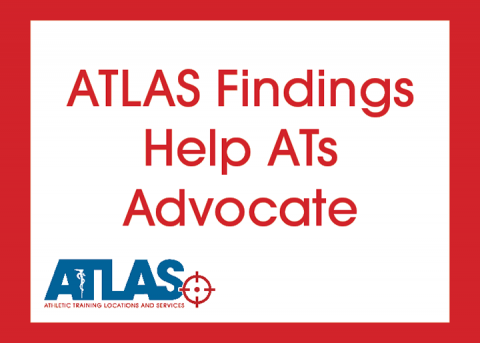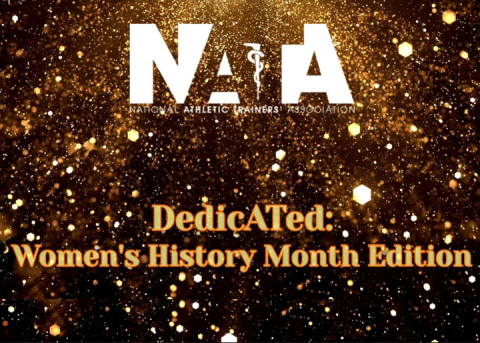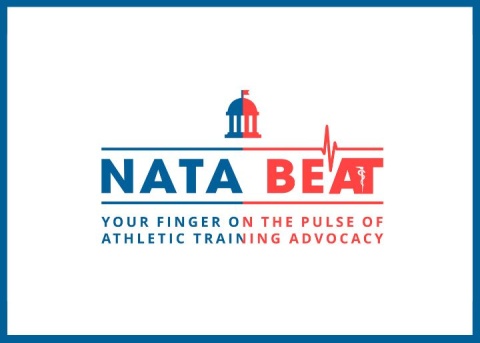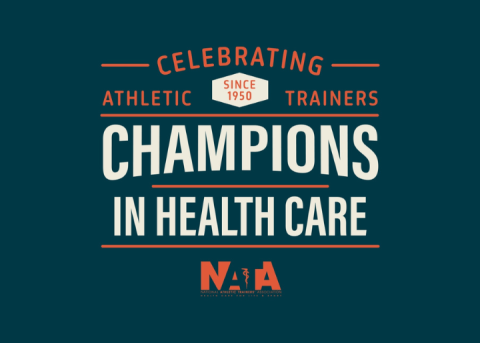
The Athletic Training Locations and Services (ATLAS) Project, a research and advocacy effort led by NATA and the Korey Stringer Institute (KSI), has concluded its findings for the 2019-20 academic year. Thanks to the athletic trainers who filled out the survey and the NATA and KSI team behind ATLAS, there are statistics to help advocate for the profession by seeking more ATs in secondary schools, stopping legislation against AT services and enhancing sports safety.
“ATLAS is a nationwide survey examining the athletic training services or extent of athletic training services at the secondary school level,” said Robert Huggins, PhD, LAT, ATC, director of the ATLAS Project and president of research and athlete performance and safety at KSI. “At KSI, we care about improving health and safety of the athletes in which ATs provide service to. ATLAS developed out of a need to describe the services provided and explore trends and information state by state so we can improve the health care provided to secondary school athletes.”
As of Aug. 1, 2019, ATLAS changed the frequency ATs take the survey. Now, athletic trainers take the ATLAS survey once every two years, and that will be considered updated in the ATLAS system.
“We [made this change because we] want to make sure we don’t have survey fatigue among high school ATs because we respect how busy they are and the time they don’t have,” Huggins said. “We want to make sure if nothing has changed in terms of services provided, there is no need to update and take the entire survey. If services have change, such as how they are employed, how many schools merged/closed, if someone was fired, etc., those are reasons for retaking the survey.”
Another addition to this academic year’s report is middle schools. Though ATLAS only tracks middle schools with athletic training services, this is progress that can help expand AT services or help ATs come up with strategies to expand to middle school athletes, Huggins said.
This year brought its challenges with the COVID-19 pandemic and, as a result, ATLAS started to ask new questions surrounding athletic training services.
“Through conversations with the NATA Secondary School Athletic Trainers’ Committee and NATA, we added COVID-19 questions because we hypothesized that ATs employed directly by school districts are less likely to be furloughed, lose their job or other [termination] than those in medical universities, including outreach hospitals,” he said. “That data could suggest job security could be improved through a school district rather than through a hospital, university or clinic.”
ATLAS has also been making news around the nation in 2020. Ohio Local 12 has frequently referenced ATLAS and has done 12 to 15 episodes on high school sports risks and athletic training policies. ATLAS has also been mentioned by Reuters and USA Today and in NATA press releases.
ATLAS Assists Projects
On top of statistics, ATLAS data has been used in different research projects, expanding its reach. One project, the Innovate Project, is a $3 million grant over the next three years that puts ATs in school districts that don’t have access to ATs. The project looks at school districts without AT representation and finds ATs to place in those districts.
“Part of this is an educational initiative,” said Erica Filep, MSEd, LAT, ATC, assistant director for ATLAS and director of sport safety and communication at KSI. “Innovate’s goal is to put ATs in historically underrepresented areas. The project has reached 10 districts so far, and ATLAS has been monumental in identifying school districts.”
Another project ATLAS has helped is the Team Up for Sports Safety (TUFSS) initiative, which is a partnership among KSI, NATA and the National Football League Foundation. The goal of TUFSS is to enhance sports safety in high schools. KSI keeps track of the policies and safety in each state, including Washington, D.C., including best practices for cardiac health, emergency action plans, heat-related issues, strength and conditioning, concussions, etc., Huggins said.
“ATLAS data has been key when we go to visit those states,” Huggins said. “KSI assists with boots-on-the-ground efforts and brings together key stakeholders. The states essentially drive the meeting and we talk about areas they are deficient and where they can improve often letting the data from ATLAS drive the policies.”
Huggins gave an example of how ATLAS data helps states. If a state’s heat safety policy doesn’t include temperature monitoring or cold tubs, ATs and key stakeholders can use ATLAS data to see if they have cold water immersion tubs or a specific temperature tool and spit out the data to them, he said.
Let’s say the state has 510 high schools, 500 which have ATs and 90 percent with ATs already have cold water immersion tub. It is much easier for a state or state high school athletic association to write a policy that mandates cold tubs if they know only 60 schools at most need a tub.
“It’s much easier to make that request and make it fundable,” Huggins said. “ATLAS is frequently in a position where it is able to provide key demographics or aggregate stats for key stakeholders, like politicians who can put forth legislation to improve safety or high school athletics associations when writing a policy to improve their state’s sports safety best practices.”
Personal Impact
Jason Cates, LAT, ATC, is the director of athletic training at Cabot Public Schools in Arkansas. In 2017, while ATs in Arkansas were trying to update the state practice act, a physical therapist, who was also a state representative and physical therapy clinic owner, was asked to draft a legislation that would do away with athletic trainers outside of the college and university setting. The reason the PT didn’t include the university setting is because the athletic organizations and universities know how important ATs are, and the representatives wouldn’t be able to fight them in the state of Arkansas, Cates said.
The legislation wouldn’t recognize ATs in any other setting, including clinical outreach, industrial and secondary school. Cates took “the grassroots effort” route to get various organizations, conferences and universities to combat the legislation.
“I worked with Robert Huggins and ATLAS to show the legislators that if you took the number of high schools with full-time ATs and multiply it by the parents, the grandparents, the potential number of registered voters tied to that athlete, including physicians, teachers, school board members, admin, etc., that number would be over 350,000 voters,” Cates said. “We used an algorithm for a fair number to show that these are the number registered voters affected. We told them that if they were allowed to run this bill, this would be the number of voters who would not vote for you to be reelected.”
Thanks to the statistical information from ATLAS that was given to the Arkansas House of Representatives, the bill had no co-signers and the Speaker of the House said the bill would not be read, Cates said.
“ATLAS was very instrumental when we were able to utilize those numbers,” Cates said. “Any statistics class will teach that you can do anything with numbers, so we did that and used numbers to our benefit to show lawmakers in the House and Senate that this is not a piece of legislation they would want to see the light of day.”
Along with the data, community members who cared for the health care of student athletes, such as principals and parents, wrote letters to their districts in an effort to get the bill removed. Within weeks, Cates was able to mobilize and show a very strong gathering of the community and state that would be affected by the riddance of athletic trainers, Cates said.
Quick Stats
Here’s a look at some quick facts from the 2019-20 academic year.
- Most ATs in the secondary school setting are employed by medical/university/facility (57 percent)
- Compared to 36 percent by the school district
- Four states are outliers with equal to or more than 82 percent of respondents providing AT services that are employed by the school district.
- New Mexico, District of Columbia, New Jersey and Texas
- Districts Four, Five and Nine have the highest percentages of respondents employed by medical or university facilities (86 percent, 76 percent and 72 percent, respectively).
- Districts Six, Seven and Eight have the lowest percentages of medical or university facilities employment (34 percent, 42 percent and 30 percent, respectively).
- City locale:
- Wyoming is the only state with 100 percent full-time AT coverage in city schools.
- Regarding AT access, Montana, North Dakota and Wyoming have AT access in 100 percent of city secondary schools.
- Suburban locale:
- No state has full-time AT services in 100 percent of suburban secondary schools; however, Nebraska, New Jersey, Pennsylvania and South Carolina have full-time AT services in more than 75 percent of suburban secondary schools.
- Hawaii, Montana, Nebraska, South Dakota and Vermont have AT access in 100 percent of suburban secondary schools.
- Rural locale:
- New Jersey is the only state with full-time AT services in more than 80 percent of rural secondary schools.
For a complete look at this academic year’s findings, visit the ATLAS webpage.




